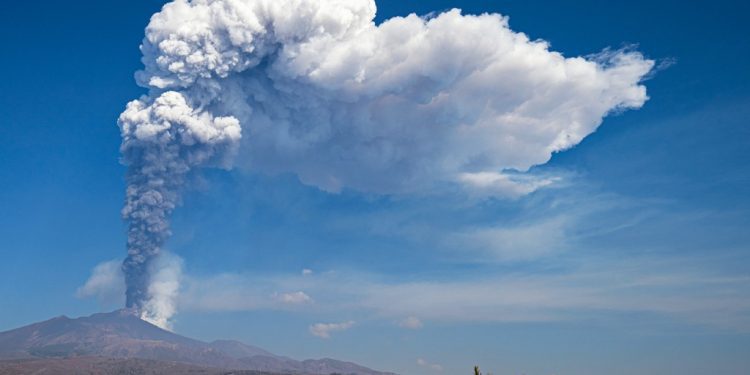CLAIM: A post is trending on Twitter, where one Archie, said the carbon emissions from the Mount Etna volcanic eruptions have given off more carbon and noxious gases than mankind has done since the dawn of time.
The post was made on May 24, 2023 following an Active volcano in Italian mount.
VERIFICATION: Mount Etna is an active stratovolcano on the east coast of Sicily, Italy. It is situated in the Metropolitan City of Catania, between the cities of Messina and Catania. Mount Etna lies above the convergent plate margin between the African Plate and the Eurasian Plate and it is the tallest active volcano in Europe, currently 3,329 m high, though this varies with summit eruptions. It is the highest peak in Italy south of the Alps.
Increased levels of volcanic activity at Mount Etna Volcano in Sicily were observed on May 21, according to the officials of the Italian Institute for Geosciences and Volcanology. Because explosive eruptive activity was occurring at the crater of the volcano, emitting an ash cloud, the Catania Fontanarossa Airport (CTA) ceased operations, with no flights able to land or take off.
Volcano and carbon emissions
A volcano refers to an opening on the surface of a planet or moon, which allows material warmer than its surroundings to escape from its interior. When this material escapes, it causes an eruption. Volcanic eruptions are often discussed in relation to climate change because they release CO2 (and other gases) into our atmosphere.
According to scientific estimates and experts in the field, human activities, particularly since the Industrial Revolution, have released significantly larger amounts of carbon dioxide and other greenhouse gases into the atmosphere compared to volcanic emissions. Though volcanic activity is considered a natural process that affects Earth’s climate, it does not explain the observable warming trend of the last century, which is primarily attributed to human-induced emissions.
NASA, a US agency, reveals that human contributions to the carbon cycle are more than 100 times those from all the volcanoes in the world-combined.
Scientific estimates from the U.S. Geological Survey indicate that the annual global CO2 emissions from both on land and submarine volcanoes range from 0.13 gigaton to 0.44 gigaton. This amount is considerably smaller compared to the CO2 emissions generated by human activities.
In 2021, data from the International Energy Agency (IEA) revealed that global CO2 emissions from energy combustion and industrial processes alone reached a record high of 36.3 billion tonnes (or gigatons). A graph provided by the IEA illustrates the increasing trend of emissions since 1899.
Boris Behncke, a volcanologist at Italy’s Etna Observatory of the National Institute of Geophysics and Volcanology (INGV), was quoted by Reuters stating that volcanoes currently contribute only a small percentage to the overall CO2 production caused by human activities.
He emphasized that human-induced CO2 emissions have drastically risen over the past decades, while volcanic emissions have remained relatively stable.
VERDICT: The notion that CO2 from Mount Etna volcanic sources exceeds manmade CO2 is FALSE.
This content was produced with support from the Independent Media Response Fund, an initiative of the Check Global Program at Meedan to respond to global challenges through hyperlocal initiatives. The fund is supported by the Swedish International Development Cooperation Agency (Sida).

